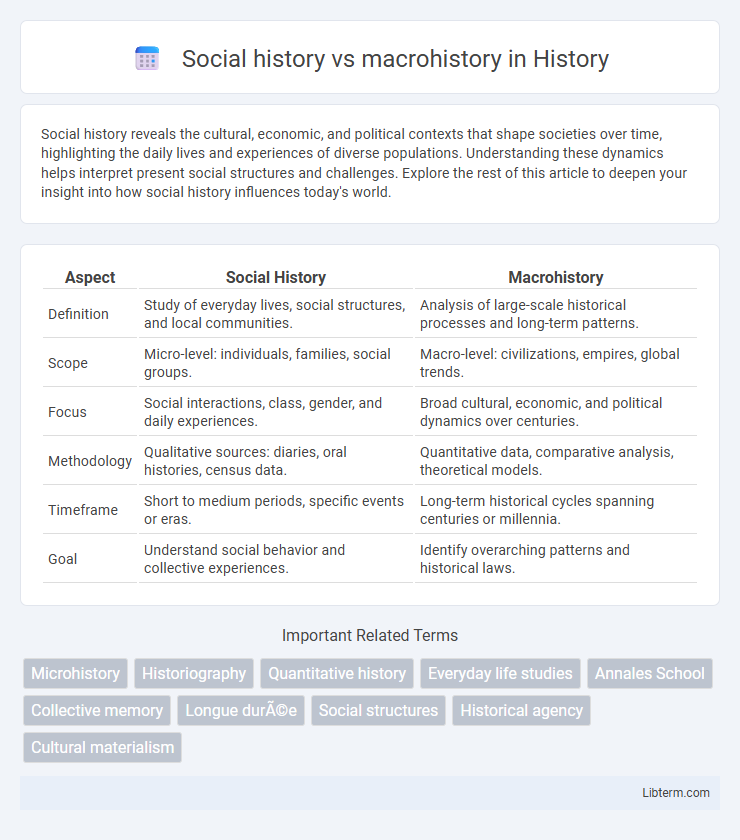Social history reveals the cultural, economic, and political contexts that shape societies over time, highlighting the daily lives and experiences of diverse populations. Understanding these dynamics helps interpret present social structures and challenges. Explore the rest of this article to deepen your insight into how social history influences today's world.
Table of Comparison
| Aspect | Social History | Macrohistory |
|---|---|---|
| Definition | Study of everyday lives, social structures, and local communities. | Analysis of large-scale historical processes and long-term patterns. |
| Scope | Micro-level: individuals, families, social groups. | Macro-level: civilizations, empires, global trends. |
| Focus | Social interactions, class, gender, and daily experiences. | Broad cultural, economic, and political dynamics over centuries. |
| Methodology | Qualitative sources: diaries, oral histories, census data. | Quantitative data, comparative analysis, theoretical models. |
| Timeframe | Short to medium periods, specific events or eras. | Long-term historical cycles spanning centuries or millennia. |
| Goal | Understand social behavior and collective experiences. | Identify overarching patterns and historical laws. |
Introduction to Social History and Macrohistory
Social history examines the lived experiences, social structures, and everyday lives of ordinary people, emphasizing micro-level analysis and qualitative data. Macrohistory investigates large-scale historical patterns, processes, and long-term dynamics, utilizing quantitative methods and broad temporal frameworks. Both approaches offer complementary insights into understanding historical developments through different scopes and methodologies.
Defining Social History
Social history examines the daily lives, experiences, and cultures of ordinary people, emphasizing grassroots perspectives and societal norms. It contrasts with macrohistory, which analyzes broad, large-scale patterns, events, and structures across long periods. Defining social history involves understanding its commitment to uncovering the lived realities of marginalized groups and social dynamics often overlooked by traditional historical narratives.
Understanding Macrohistory
Macrohistory examines long-term social, economic, and political structures to identify patterns and causal mechanisms shaping civilizations over centuries or millennia. Unlike social history, which concentrates on the experiences and agency of individuals and communities, macrohistory prioritizes broad trends such as demographic shifts, technological innovations, and institutional developments. This approach enables historians to analyze systemic transformations and global interactions that influence historical trajectories on a grand scale.
Key Differences Between Social History and Macrohistory
Social history concentrates on the lived experiences, daily lives, and social dynamics of ordinary people, providing detailed insights into specific communities or groups. Macrohistory examines broad structural changes, large-scale patterns, and overarching historical processes spanning extensive timeframes and regions. The key differences between social history and macrohistory lie in their scope, focus, and methodology, with social history prioritizing micro-level analysis and individual agency, while macrohistory emphasizes systemic transformations and long-term trends.
Methodologies in Social and Macrohistorical Research
Social history employs micro-level methodologies such as archival research, quantitative analysis of census data, and oral histories to examine everyday experiences and local contexts. Macrohistorical research uses large-scale comparative methods, including structural analysis, long-term trend identification, and global data synthesis to understand broad socioeconomic patterns over centuries. Combining qualitative micro evidence with quantitative macro data enhances the multidimensional study of historical processes.
Major Theorists and Influencers
Social history emphasizes the experiences of ordinary people and grassroots movements, with major theorists like E.P. Thompson and Eric Hobsbawm highlighting class struggles and everyday life. Macrohistory, influenced by thinkers such as Fernand Braudel and Immanuel Wallerstein, explores long-term structural patterns and global systems like world-systems theory. Both fields shape historical analysis by integrating micro-level social dynamics and broad systemic frameworks.
Scope and Scale of Analysis
Social history emphasizes the detailed study of everyday lives and experiences of ordinary people, focusing on small-scale, micro-level interactions within specific communities or groups. In contrast, macrohistory examines large-scale historical processes and long-term structural changes across broad regions or even global contexts over extended time periods. The scope of social history is narrow and granular, while macrohistory adopts a broad, systemic perspective to analyze overarching patterns and trends.
Common Themes and Case Studies
Social history emphasizes the experiences of ordinary people, exploring themes like class, gender, and community through detailed case studies such as labor movements and family life. Macrohistory focuses on large-scale historical processes and patterns, including empire expansion, economic systems, and civilizational shifts, exemplified by studies of the Industrial Revolution or globalization. Both approaches intersect in examining power dynamics, social structures, and cultural transformations, providing complementary perspectives on historical change.
Impact on Modern Historical Interpretation
Social history emphasizes the experiences and daily lives of ordinary people, shaping modern historical interpretation by providing a nuanced understanding of societal dynamics and cultural shifts. Macrohistory analyzes large-scale historical processes and patterns, influencing contemporary perspectives by highlighting broad trends and structural transformations across civilizations. The integration of both approaches enriches interpretations, balancing micro-level human agency with macro-level systemic forces in the study of history.
Future Directions in Historical Scholarship
Social history emphasizes individual and community experiences, while macrohistory analyzes large-scale societal patterns and processes over long periods. Future directions in historical scholarship involve integrating digital humanities and big data analytics to bridge micro-level social narratives with macrohistorical trends. This interdisciplinary approach enhances understanding of historical complexity through computational modeling and cross-temporal analysis.
Social history Infographic

 libterm.com
libterm.com